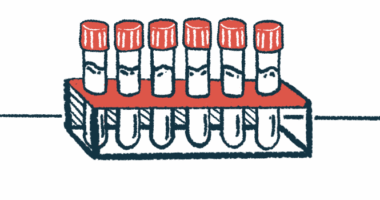ALS biomarkers are lowered with Coya’s Treg therapy: Study
Measuring inflammation, oxidative stress could help track treatment response

Treatment with regulatory T-cells (Tregs), a type of anti-inflammatory immune cell, reduced biomarker levels of inflammation and oxidative stress in people with amyotrophic lateral sclerosis (ALS), a study shows.
The experimental approach may help curb these contributions to nerve cell damage in ALS, the findings suggest, and routinely measuring the biomarkers could aid in monitoring responses to Treg treatment.
“The simultaneously assessed levels of immunological and oxidative factors are candidates to monitor disease progression and to properly target clinical trial endpoints response to [Treg] therapy in ALS,” the researchers wrote in “Immunological, oxidative, and structural factors and their responses to regulatory t lymphocyte therapy in amyotrophic lateral sclerosis,” which was published in Ageing and Neurodegenerative Diseases.
In ALS, motor neurons, the nerve cells that control voluntary movements, become damaged and die. As a result, the brain progressively loses control of movement, triggering symptoms such as muscle weakness, atrophy (shrinking), and stiffness.
Biological hallmarks associated with motor neuron loss include an overactive inflammatory response and oxidative stress, a type of cell damage caused by highly reactive oxygen-containing molecules generated from normal metabolism. Oxidative stress is increased in ALS and likely contributes to disease progression.
“Our pre-clinical studies have suggested that oxidative stress results from and promotes neuroinflammation and neuronal injury in ALS,” Stanley Appel, MD, scientific advisory board chairman of Coya Therapeutics said in a company press release. Coya is developing two investigational anti-inflammatory treatments for ALS that boost Treg function.
Treg therapy’s effect on inflammation, oxidative stress
In the new study, Appel and his colleagues at Houston Methodist Hospital, Texas examined the levels of various blood-based biomarkers associated with inflammation, oxidative stress, and nerve cell structural integrity in 30 people with sporadic ALS (63.3% male). The samples were compared to those from 10 age-matched healthy people (controls).
Blood tests revealed significantly elevated levels of CCL2, an immune signaling molecule associated with inflammatory responses, compared with healthy people. CCL2 levels were particularly increased in patients with rapid ALS progression over those progressing more slowly, although this group’s levels were still significantly higher than the controls’.
Similarly, the pro-inflammatory signaling protein interleukin-18 (IL-18) was significantly elevated in patients versus controls and in patients whose disease was progressing rapidly compared with those progressing slowly.
4-HNE, an oxidative stress marker, was also significantly increased in ALS patients with rapidly progressive disease, but slower progressors had levels similar to controls. MDA, another oxidative stress marker, was elevated in both patient groups versus controls, indicating it didn’t correlate with disease progression.
Levels of NfL and pNfH, two markers of nerve cell damage were examined too. NfL was elevated in rapidly progressing patients compared with slow progressors, but the patient groups didn’t differ significantly from healthy people. pNfH was reduced in rapidly progressing patients compared with controls, but no other group differences were observed.
Biomarkers of treatment response
To validate the biomarkers as indicators of treatment response, the researchers tested samples from ALS patients who participated in one of two clinical trials.
A Phase 1 pilot trial (NCT03241784) enrolled three people with ALS and treated them with a Treg therapy called COYA 101 (formerly ALS001). Tregs are white blood cells that suppress immune responses and prevent unnecessary inflammation.
The cells were isolated, grown to greater numbers in a laboratory, and then infused back into the same patient. The participants also received interleukin-2, an immune signaling protein that boosts Treg function. Data, published in 2018, showed it slowed progression rates during the early and later stages of the disease.
The Treg/IL-2 combination therapy also suppressed CCL2, IL-18, and 4-HNE, and stabilized clinical status, as assessed with the Appel ALS (AALS) scoring system. During a “washout” period without Treg therapy, the biomarker levels increased and clinical status deteriorated.
A Phase 2a study (NCT04055623) investigated COYA 101 in ALS patients given monthly infusions for six months. A six-month, open-label extension followed.
In this trial, the combination therapy suppressed CCL2 levels in five of the eight patients and IL-18 levels in six. 4-HNE levels were elevated in two patients, but remained low in six. As previously reported, COYA 101 reduced ox-LDL, another marker of oxidative stress, in both the Phase 1 and Phase 2a study patients.
“It is gratifying that biomarkers of oxidative stress — 4-HNE and ox-LDL — correlated with responsiveness to therapy in 2 ALS clinical trials of Treg-enhancing therapies, and may provide an objective confirmation of clinical benefit in forthcoming trials,” Appel said.
“Immunological and oxidative pathological factors accurately reflected therapeutic responses in these pathways and are candidates to target clinical trial endpoints,” the researchers said.
The biomarkers will help assess the effectiveness of COYA 302, a combination of IL-2 and a fusion protein known as CTLA4-Ig or abatacept, Coya maintains. This therapy is designed to further increase Treg activity, reduce inflammation, and slow disease progression.
So far, in a small proof-of-concept clinical trial, four ALS patients saw a marked slowing in disease progression with COYA 302. The company plans to file a request with U.S. regulators to continue testing COYA 302 in a Phase 2 clinical trial.






